If there were any remaining questions about whether the Patriots are unkillable, Sunday night’s 23–21 win over the Cardinals provided an answer. It amounted to proof that Bill Belichick is destined to walk the earth for all of eternity, sucking the life from his victims and bringing doom to the NFL. The Pats boarded a plane this week to go face a loaded Cardinals team; New England was without a four-time Super Bowl–winning QB, the league’s best tight end, and two of its starters along the offensive line. It just didn’t matter. In terms of personnel, I’m not quite sure what would anymore.
The Patriots have won double-digit games in 14 of the past 15 seasons, and Sunday’s showing in the desert was the latest example of how this stretch of dominance has been made possible. Quarterback Jimmy Garoppolo looked excellent in his starting debut (24-of-33 passing for 264 yards and a touchdown), filling in for the suspended Tom Brady, and it was immediately apparent that offensive coordinator Josh McDaniels would give him every chance to succeed.
Especially with New England’s patchwork offensive line, the Cardinals came into Week 1 holding two distinct advantages: Their solid front four would face another reworked Patriots line featuring second-tier options like Cameron Fleming, Ted Karras, and Marcus Cannon, and cornerback Patrick Peterson would likely smother whichever receiver the Pats were willing to sacrifice to his side. McDaniels responded by taking both matchups out of the equation. New England’s receivers ran routes that were specifically designed to exploit the man coverage that Arizona loves, and a majority of the Patriots’ plays were aimed at rookie cornerback Brandon Williams.
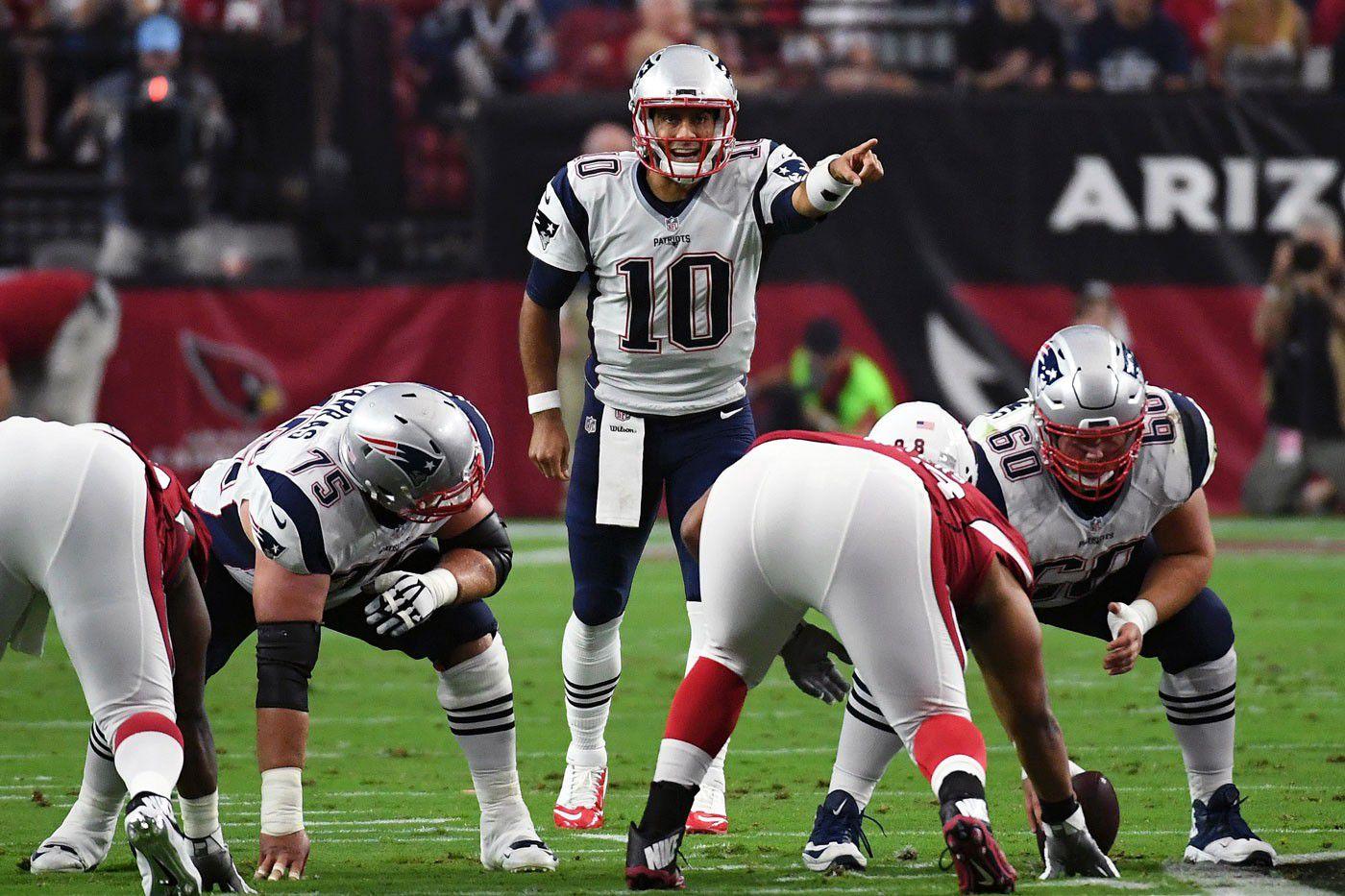
By giving his QB quick throws dictated almost entirely by the coverage, McDaniels both simplified Garoppolo’s approach and made any offensive line deficiencies irrelevant. Wideout Julian Edelman’s ability to win early on routes when singled up on cornerbacks is remarkable, and with tight end Rob Gronkowski nursing a left hamstring injury back in Boston, Edelman was the focal point of New England’s passing game. He caught all seven of his targets for 66 yards, and made three grabs for first downs on the Patriots’ opening drive of the game. His value to this offense will probably never get its due given the planet-destroying potency of Brady and Gronk, but it was on full display.
Having a steady weapon like Edelman was crucial in getting Garoppolo acclimated, but in his first meaningful action, the 24-year-old quarterback did more than simply lean on the Pats’ no. 1 receiver. Williams was caught staring into the backfield on the 37-yard touchdown that Garoppolo threw to Chris Hogan on New England’s opening drive, but the ball placement and decision to take a shot against single coverage would have been on point either way.
For most of the game, Garoppolo embodied the “Do what we tell you to do, and it’ll work out just fine” ethos that defines Belichick’s Patriots. But as Arizona made second-half adjustments, the quarterback showed off enough improv ability to make it clear that New England will remain in good hands even when things don’t go perfectly according to plan in these next three weeks without Brady.
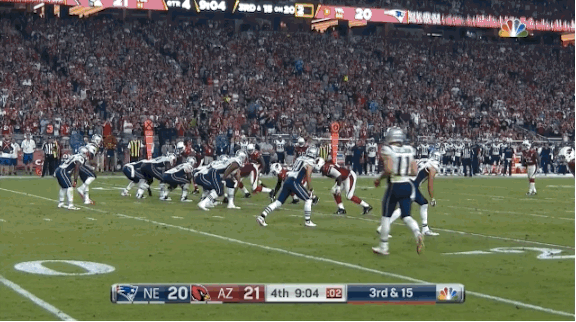
Arizona’s choice to play more zone in the second half meant that Garoppolo had fewer instant decisions, but he was still up to the task when it mattered. His subtle mobility is the one advantage Garoppolo has over his two-time MVP predecessor, and it will serve him well playing behind New England’s line for the rest of the month. It also led to his defining play of the night, a 32-yard strike that Garoppolo delivered to Danny Amendola on a third-and-15 after dodging the rush and moving up and out of the pocket. That fourth-quarter drive culminated with a Stephen Gostkowski field goal that put the Patriots ahead by two points. Despite Cardinals receiver Larry Fitzgerald’s predictable, late-game heroics, that lead would prove to be enough.
The lesson here is twofold: First, Las Vegas should never list the Pats as 9.5-point underdogs, even if Belichick benches Garoppolo and starts himself at quarterback. Second, New England is well positioned not only to survive in Brady’s four-game absence, but to cruise in the AFC East. The Jets, Bills, and Dolphins all lost Sunday.
Along with Garoppolo’s stellar debut, the Pats also showed off the type of defense that should rank among the league’s best. With Dont’a Hightower and Jamie Collins both able to play on the edge as pass rushers and Chris Long now in the fold, New England has a deep, flexible stable of guys up front that will give opponents fits all season. And just like they did on offense, the Patriots had a defensive plan on Sunday that gave them the upper hand before kickoff. By taking away the deep shots Arizona loves, New England forced Carson Palmer to beat it with smaller bites.
New England’s approach in Sunday’s game is what we should now expect from the Pats — finding the smallest weaknesses (the presence of Williams at cornerback, first-year starter D.J. Humphries at right tackle, and backup Earl Watford at right guard) and exploiting them in every way possible. New England went on the road against what might be the most talented roster in the league and thoroughly outplayed it. As Belichick has constantly reminded everyone, a stacked roster can only take you so far. The way it’s deployed will always matter most, and as it’s been so often, Belichick and his staff squeezed all it could from the Patriots on the field.
The Buccaneers Show What’s Possible
Early in the first half of Sunday’s game at Atlanta, the Buccaneers offense appeared to be plagued by the same damning problems that hindered it in 2015. Deep in its own territory, Tampa Bay followed a Charles Sims run with two consecutive penalties and a Jameis Winston interception that stemmed from a miscommunication between him and receiver Vincent Jackson. The Falcons punched the ball in for a score, and just like that the Falcons led 10–3. Then the show really started.
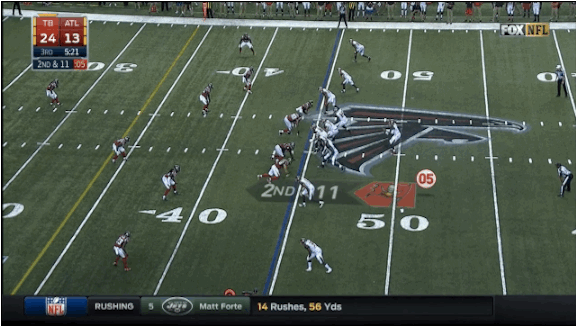
After throwing that first-quarter pick, Winston was 2-of-6 for 11 yards. From that moment on, he went 21-of-27 for 270 yards with four touchdowns, including what might have been the two best throws of the day that didn’t belong to Aaron Rodgers. Atlanta’s defense might not offer the best barometer, but this version of the Bucs’ passing game is what seemed possible before the season began. A more refined Winston combined with the sort of weapons Tampa Bay boasts on the outside can make for a lethal combination, and Winston’s touchdown tosses to Mike Evans and Austin Seferian-Jenkins were the type of in-control-but-aggressive shots that point to his increased comfort with a year of experience in play caller Dirk Koetter’s system.
If Tampa Bay’s running backs (who combined to make eight catches for 66 yards) and second-year wideout Adam Humphries — who did nice work with a short screen up the left sideline en route to the Bucs’ first touchdown — can round out the offense and provide Winston some different targets that aren’t pass-catching power forwards, this unit could emerge as a nightmare for opposing defenses.
Theo Riddick Exemplifies the Lions’ Offensive Plan
All hail Jim Bob Cooter. The Lions offensive coordinator said last week that he wasn’t concerned with the emergence of a true no. 1 receiver following Calvin Johnson’s retirement. He believed that the best version of Detroit’s 2016 attack would feature a host of pass-catching options all doing their part as an equal-opportunity approach, and on Sunday, he got exactly that.
No Lions pass catcher hauled in more than seven receptions against the Colts, and six guys recorded at least three. Two key injuries to the Indianapolis secondary (safety T.J. Green and cornerback Patrick Robinson) helped Detroit’s cause, but Cooter’s offense may have shined regardless of the circumstances. Matthew Stafford continued his surge from late last season, going 31-of-39 for 340 yards with three scores in a 39–35 win.
Detroit boasts a slew of weapons in the passing game, but even in a group that includes Golden Tate and Marvin Jones, the unique qualities that running back Theo Riddick brings to this offense stand apart. After catching 80 passes in 2015, Riddick reeled in five more for 63 yards on Sunday. What was even more notable, though, was the importance he had in Cooter’s red zone approach.
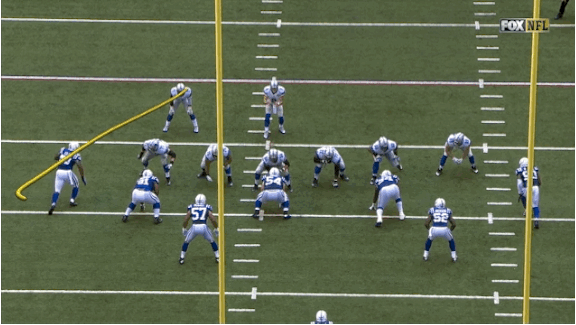
The Lions do an excellent job of both using route combinations to manufacture space near the goal line and giving Riddick chances to take advantage of all that green. On their touchdown drive to open the second quarter, they isolated Riddick on an angle route against linebacker Josh McNary, a matchup sure to end in carnage for any defense. But Cooter’s real flourish came on Detroit’s tiebreaking touchdown late in the fourth.
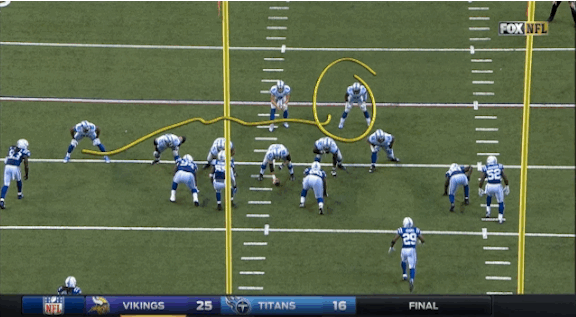
By clearing tight end Eric Ebron out from the right side, the Lions ensured that Indy linebacker D’Qwell Jackson, no. 52, would be sucked the other direction. That left Sio Moore alone to cover half of the field, with right guard Larry Warford barreling his way. A numbers advantage and Riddick’s elusiveness in space make that a win for the Lions every time.
Last week, the Lions gave Riddick — a 2013 sixth-round pick out of Notre Dame — a three-year, $12.8 million deal, and based on the role it seems like he’s going to have in their offense, that might prove to be a bargain.
The Starting Lineup
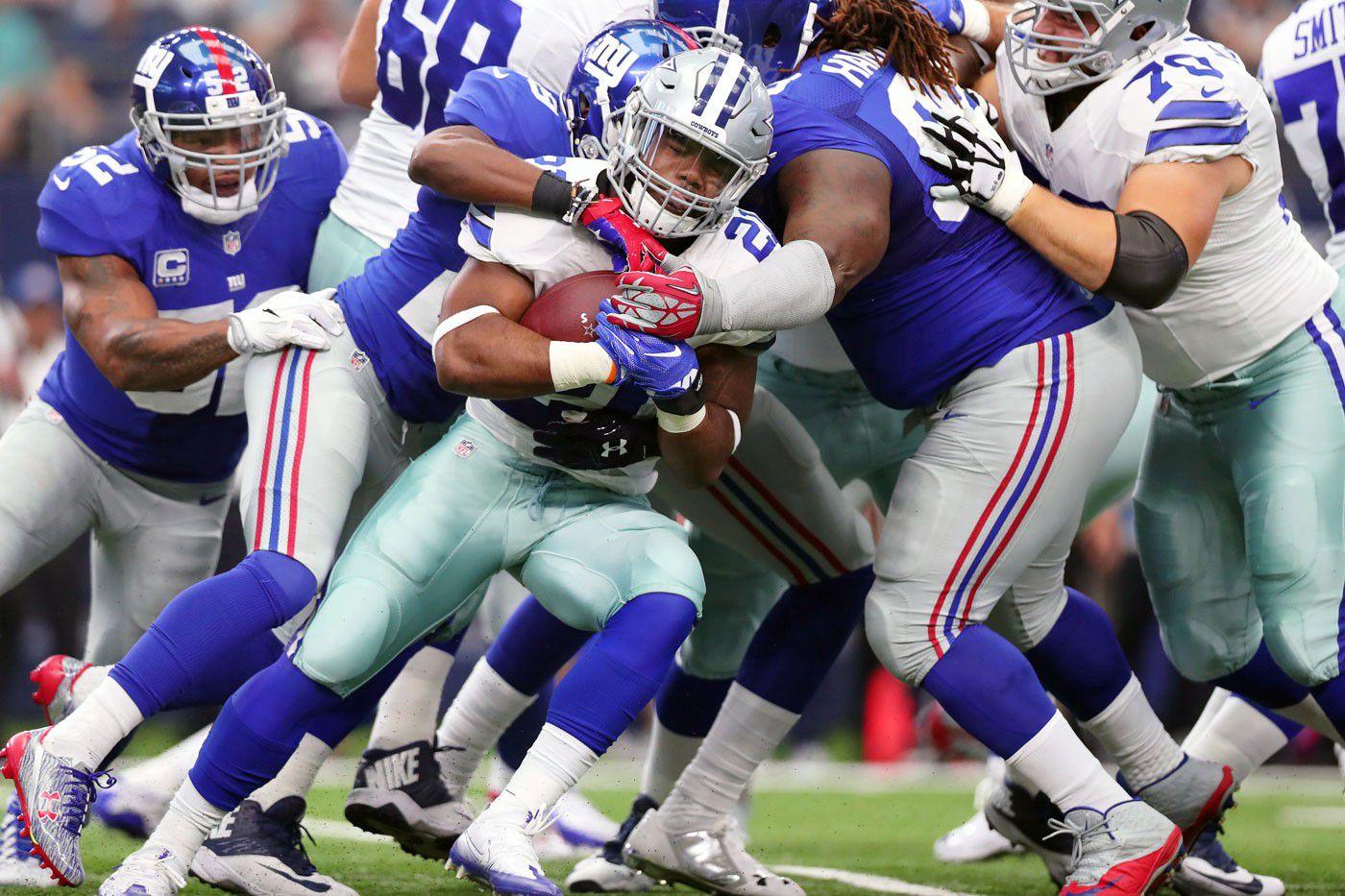
1. The clash between the Cowboys offense and the Giants defense featured a lot of new faces, and in this round at least, New York’s defense won as part of a 20–19 victory. Rookie quarterback Dak Prescott looked comfortable from the start — he completed 13 of his first 16 passing attempts — but Dallas had nothing available down the field all game. Those first 13 completions went for only 126 yards; Prescott finished the day averaging 5 yards per attempt.
The Cowboys’ running game wasn’t any more efficient. Ezekiel Elliott managed just 51 yards with a touchdown on 20 carries, as the Giants’ defensive line made an early case for being the most improved position group in football. General manager Jerry Reese’s response to finishing 30th in defensive DVOA last season was to toss a comical amount of money at bolstering the team’s front four, and that decision seems to be paying off.
Olivier Vernon, in particular, was excellent in his debut for Big Blue. Defensive coordinator Steve Spagnuolo bumped him inside on both run and pass downs in an effort to create mismatches with left guard La’el Collins. It worked more than once.
2. Week 1 couldn’t have gone any better for the Texans. The franchise’s plan this offseason was transparent: bring in some offensive playmakers (quarterback Brock Osweiler, running back Lamar Miller, and rookie deep threat receiver Will Fuller), and ride the pass rush to another top-10 defense. All of that showed up Sunday in a 23–14 win over Chicago.
Houston’s defensive line made Sad Jay Cutler face a fixture on my TV. The Bears QB was sacked five times (and hit eight more), and not a single one came courtesy of J.J. Watt. Former no. 1 overall pick Jadeveon Clowney might be poised for a breakout season, and if that’s the case, the rest of the AFC South should hide.
On offense, Miller got the type of heavy workload he never did in Miami (28 carries for 106 yards; he’s the only 100-yard back in the league so far), and the speedster Fuller hinted at what’s to come: He had two long gains and dropped a would-be touchdown. Save for one forced interception to a bracketed DeAndre Hopkins, Osweiler looked capable in his first go of it with the Texans.
3. Now we know why Vikings GM Rick Spielman was willing to pay for Sam Bradford. Quarterback Shaun Hill’s final Week 1 line — 18-of-33 passing for 236 yards — doesn’t look terrible, but those numbers were massaged by receiver Stefon Diggs hauling in seven of nine targets on mostly contested catches in traffic. Minnesota’s offense was blooper-reel bad at times, and Adrian Peterson averaged 1.6 yards per carry against a run defense that finished 24th in DVOA last year.
In a 25–16 win over the Titans, the Vikings defense was its offense. When the Packers and Aaron Rodgers come to town next week, though, that won’t be enough. It has to be Bradford’s turn.
4. This is not a throw any human being should be able to make — which is a reminder that Aaron Rodgers is not human.
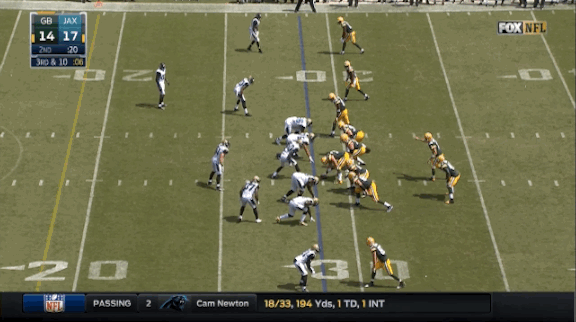
5. It feels strange that a player who came into the 2016 season averaging 81.2 yards per game in his career may be ready to make a leap, but if receiver A.J. Green’s Week 1 performance is any indication, it’s true. With Cincinnati quarterback Andy Dalton’s other top targets either gone (Marvin Jones, Mohamed Sanu) or hurt (Tyler Eifert), Green was the Bengals’ passing game, and he put Darrelle Revis through a shredder, hauling in 12 of 13 targets for 180 yards with a touchdown in a 23–22 victory.
6. Had they faced any team that doesn’t have Green, the Jets probably would have won Sunday based on their pass rush alone. New York’s interior tried to break Dalton. No QB in the league was pressured less last season; that didn’t stop Leonard Williams, Muhammad Wilkerson, and others from piling up seven sacks and hitting Dalton 10 times. And, oh yeah, the Jets get Sheldon Richardson back from suspension next week. I already feel bad for Bills quarterback Tyrod Taylor.
7. The Seahawks survived the Dolphins as double-digit home favorites in Week 1, but they’re playing with fire offensively. In Seattle’s come-from-behind 12–10 win, Russell Wilson had to dodge pass rushers like oncoming cars, something that ended poorly for the Pro Bowl quarterback.
Trying to pull his patented spin-away-from-this-like-it’s-nothing routine as Miami’s Ndamukong Suh gave chase, Wilson twisted his right ankle and moved gingerly for the rest of the game. Even if he isn’t forced to miss time and the Seahawks escape relatively unscathed, the scare serves as a reminder of the risk Seattle takes every play that Wilson has to settle in behind that awful line.
8. The Raiders made Kelechi Osemele the richest guard in football this offseason because he can turn defensive tackles into scorch marks. But at least part of the front office’s rationale for signing him was his ability to play tackle in a pinch. That’s exactly what happened Sunday. Already without 2015 starting right tackle Austin Howard, the Raiders lost Menelik Watson against the Saints late in the second quarter.
Oakland responded by moving left tackle Donald Penn to the right side and shifting Osemele out to left tackle. For a lot of teams, that type of shuffling could be a death sentence, but the Raiders’ flexibility allowed for a midstream change at both tackle spots that didn’t short-circuit their chances to pull off one of the statement wins of the week. They took a 35–34 thriller that was sealed on a two-point conversion.
9. I’ll wait to anoint Carson Wentz as the Eagles’ savior until he plays against a team that isn’t the Browns, but the rookie quarterback looked great in his first start. His two passing touchdowns — both perfectly placed deep balls up the sideline — represent an element that Philadelphia’s offense lacked with Sam Bradford. The Eagles had 12 touchdown throws of 19 yards or more during the entire 2015 campaign. After beating Cleveland 29–10 in Week 1, they already have two in 2016.
10. Jacksonville’s final play call in its 27–23 loss to the Packers, a quick hitch to Allen Hurns on a fourth-and-1 from Green Bay’s 14-yard line, was emblematic of many offensive approaches throughout the day. Week 1 felt much like the first round of a boxing match, with teams feeling each other out and taking what defenses allowed. The Bills seemed especially content to attack the underneath parts of Baltimore’s defense, rather than take the deep shots that defined their passing game last year. After going down 13–7, I’d be surprised to see another day in which Buffalo’s Taylor averages 5 yards per attempt.
11. The Chargers’ second-half collapse in a 33–27 overtime loss to the Chiefs was made even worse by the news that star receiver Keenan Allen likely tore his ACL. He missed the final eight games of the 2015 season with a lacerated kidney, and Allen was clearly devastated as he was carted off the field in the second quarter.
San Diego’s offense wasn’t the same without him; QB Philip Rivers completed nine of his first 10 passing attempts for 112 yards to wide receivers, including 6-of-7 to Allen for 63 yards. After Allen went down, Rivers went 7-of-13 for 60 yards. The Chargers offense seems to face major questions about health every year, and before even getting to Week 2, they’ve already lost one of their centerpieces.
An earlier version of this story misstated when Menelik Watson left Sunday’s Raiders-Saints game with an injury. It was near the end of the second quarter, not the fourth.